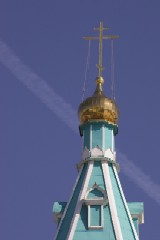Cupolas: Beautiful and Useful Throughout History
Fun Trivia Cupolas are decorative spherical roofs that look like upside down cups, usually topping circular, square, or multi-angular buildings. In some cases, cupolas form the entire roof of a tower or spire, but they usually function as ornamental additions. They are popular nowadays in Greek revival architecture in certain parts of states like Virgina, Kentucky, New York and Pennsylvania. Here they function almost like little attic rooms, in circular, rectangular, square, or octagonal shapes.
Cupolas are decorative spherical roofs that look like upside down cups, usually topping circular, square, or multi-angular buildings. In some cases, cupolas form the entire roof of a tower or spire, but they usually function as ornamental additions. They are popular nowadays in Greek revival architecture in certain parts of states like Virgina, Kentucky, New York and Pennsylvania. Here they function almost like little attic rooms, in circular, rectangular, square, or octagonal shapes.
Cupolas are generally used for one or more of three purposes: admitting light, providing ventilation, and offering a lookout. Since the construction of the first barn, cupolas have served a highly important purpose. Many barns contain hay stacked in high towers in order to accommodate greater amounts in less space. Cupolas on top of barns contain holes that constantly draw in circulating air, which dries the hay stored nearest to the top of these stacks. Northern farmers of old used to fondly call the cupola “a roof over a hole in the roof.”
The word “cupola” used to refer to the tiny domes that admitted light into Greek or Roman cathedrals, located on their roofs. “Cupola” stems from the Latin words “cupula,” “cupella,” (denoting a vault that looks like an inverted cup), and “cupa,” which, literally translated, means “little barrel” or “little cup.” The history of the word can be traced back even farther to Islamic architecture of the eighth century. People at that time put shields over the minarets of mosques both in order to keep bad weather and its effects on the building to a minimum, and to provide light and fresh air. Most people nowadays use the word to signify the domes on top of American barns, stables, and public buildings.
Certain roof cupolas called belvederes offer a high, expansive view of the surrounding area. Belvederes, also known as “widow’s walks,” are accessible by climbing an inside stairway. The word “belvedere” comes from the Italian, and means a “fair view.” Other cupolas, known as lanterns, contain strategically placed windows to let light in to the building below. As opposed to belvederes, lanterns may not be accessible from the inside.
Cupolas add dignity, importance, and a sense of power to many public buildings and churches in various countries throughout the world. They also serve to evoke a sense of nostalgia and American heritage when viewed on top of American farms and stables. Cupolas are both beautiful and useful structures, combining aesthetics and utility to any building they adorn.
